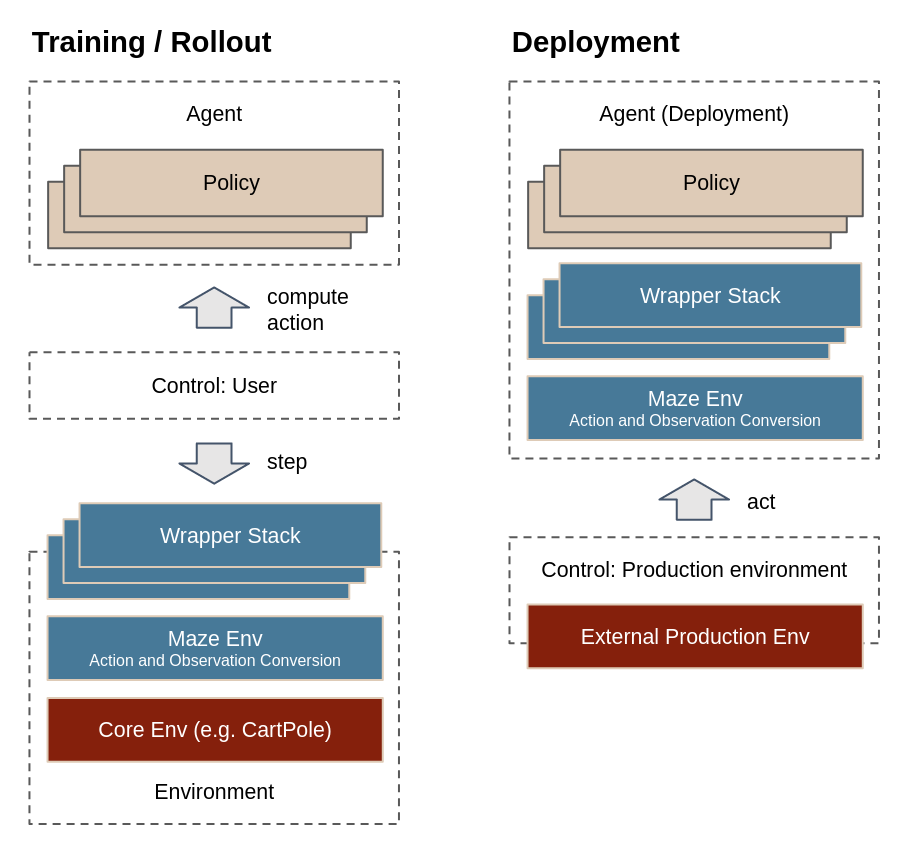Deployment¶
In an experimental setting, deploying an agent means running a rollout on a given test environment and evaluating the results. However, in a real-world scenario, when we are dealing with a production environment, running a rollout is usually not so easily feasible.
The main difference between experimental rollouts and real-world environments is that production environments often do not follow the Gym model and cannot be easily stepped. Instead, the control flow is inverted, with the environment querying the agent for an action, whenever it is ready.

The catch here is that in the Gym environment model, the wrappers that modify the environment behavior are considered to be a part of the environment (i.e., they are stepped together with it). However, during deployment, the production environment expects the wrapper stack to be maintained by the agent (after all, the production environment should not concern itself with the likes of observation post-processing and step-skipping).
The AgentDeployment component in Maze deals with
exactly this matter – packaging the policy together with the wrapper
stack and other components, so you can only call act in
a production setting and get a processed action back, with things
like statistics logging and observation frame stacking staying intact.
Building a Deployment Agent¶
There are two ways to build a deployment agent – either from an already-instantiated policy and environment (which may include a stack of wrappers):
from maze.core.agent_deployment.agent_deployment import AgentDeployment
from maze.test.shared_test_utils.dummy_env.agents.dummy_policy import DummyGreedyPolicy
from maze.test.shared_test_utils.helper_functions import build_dummy_maze_env
agent_deployment = AgentDeployment(
policy=DummyGreedyPolicy(),
env=build_dummy_maze_env()
)
Or, by providing configuration dictionary for the policy and environment (and, optionally, for wrappers) obtained from hydra or elsewhere:
from maze.core.agent_deployment.agent_deployment import AgentDeployment
from maze.core.utils.config_utils import read_hydra_config
# Note: Needs to be a rollout config (`conf_rollout`), so the policy config is present as well
cfg = read_hydra_config(config_module="maze.conf", config_name="conf_rollout", env="gym_env")
agent_deployment = AgentDeployment(
policy=cfg.policy,
env=cfg.env,
wrappers=cfg.wrappers
)
(The configuration structure here is shared with rollouts. To better understand it, see Rollouts.)
Alternatively, you can mix and match these approaches, providing an already-instantiated policy and an environment config, or vice versa.
After that, you can already start querying the agent for actions using
the act method:
maze_action = agent_deployment.act(maze_state, reward, done, info)
When the episode is done, you should close the agent deployment. At this point, the agent deployment resets the env to write out statistics and ensure all wrappers finish the episode properly.
Note
Ensure that you query the agent for actions from a single episode, in order as the states are encountered. Otherwise, parts of the wrapper stack (like stats logging or observation frame stacking) might become inconsistent, leading to passing wrong observations to the policy.
Note
Currently, the Agent Deployment supports a single episode only.
Once the episode is done, close the deployment and initialize a new
instance. Support for continued resets will likely be added in the future.
The full working example below demonstrates the agent deployment
on Gym CartPole environment, where we initialize the agent deployment
and then use the external_env
to simulate an external production env (to obtain states from),
looks like:
import gym
from maze.core.agent.random_policy import RandomPolicy
from maze.core.agent_deployment.agent_deployment import AgentDeployment
from maze.core.wrappers.maze_gym_env_wrapper import GymMazeEnv
env = GymMazeEnv("CartPole-v0")
policy = RandomPolicy(action_spaces_dict=env.action_spaces_dict)
agent_deployment = AgentDeployment(
policy=policy,
env=env
)
# Simulate an external production environment that does not use Maze
external_env = gym.make("CartPole-v0")
maze_state = external_env.reset()
reward, done, info = 0, False, {}
for i in range(10):
# Query the agent deployment for maze action, then step the environment with it
maze_action = agent_deployment.act(maze_state, reward, done, info)
maze_state, reward, done, info = external_env.step(maze_action)
agent_deployment.close(maze_state, reward, done, info)
Notice that above, we are dealing with Maze states and Maze actions, i.e., in the format they come directly from the environment. The translation to policy-friendly format of actions and observations is handled as part of the wrapper stack (where they are passed through action/observation conversion interfaces and the individual wrappers).
How does this work under the hood?¶
When initializing the AgentDeployment, an existing
environment including the wrapper stack is taken (or first
initialized, if environment configuration was passed in).
Then, the core environment (the component just under the maze environment,
providing the core functionality – see Maze Environment Hierarchy)
is swapped out for so called ExternalCoreEnv, and then
executed in a run loop with the provided policy on a separate thread.
The external core env hijacks execution of the step function, and
pauses the thread, waiting until new maze_state object
(with associated reward, etc.) is passed in from the AgentDeployment,
which runs on the main thread.
Despite what this looks like at the first glance, this is not a concurrent setup. The threads are used only for hijacking the execution in the step function, and they never run concurrently during env stepping.
Either the main thread, or the second thread are always paused. First, the environment on the second thread is waiting for obtaining the next maze state from agent deployment on the first thread. Then, agent deployment is waiting for the environment run loop to iterate to the next step function, and return the processed action back.
Where to Go Next¶
To better understand the hierarchy of Core Env, Maze Env and Wrappers and how they affect the execution flow, see Maze Environment Hierarchy
Before deployment, you might want to train your own policy and then evaluate it using rollouts.